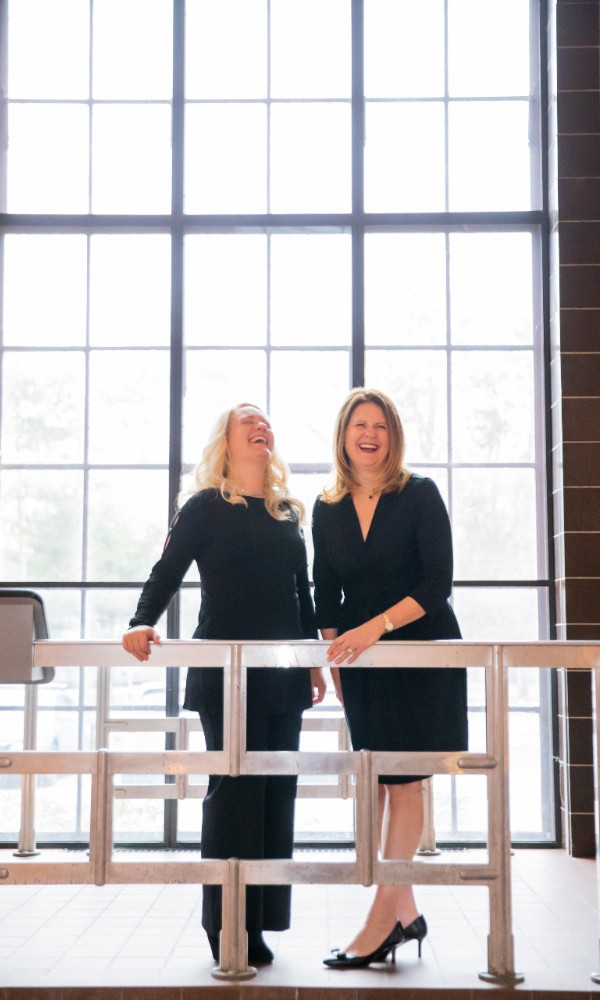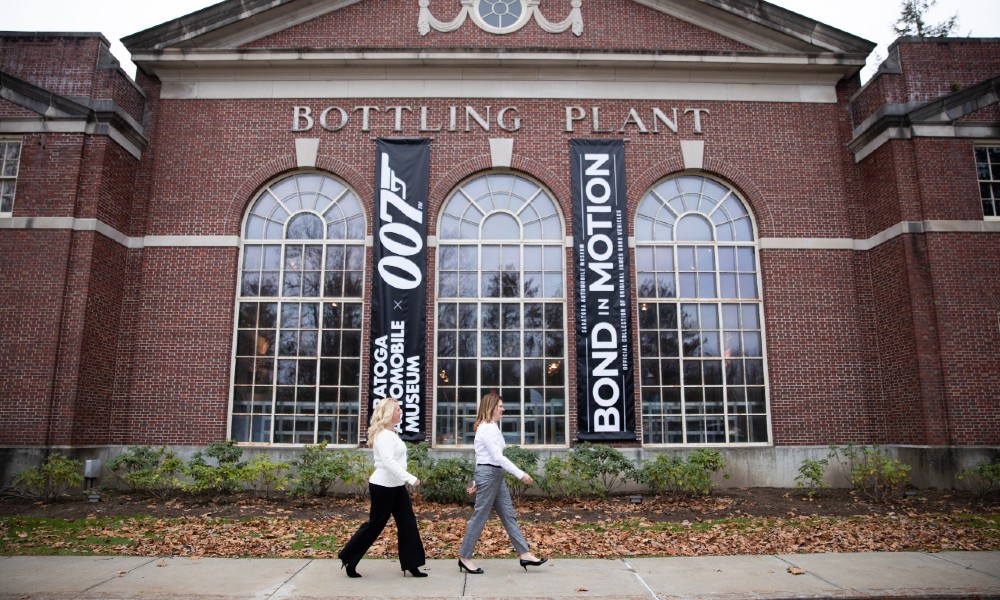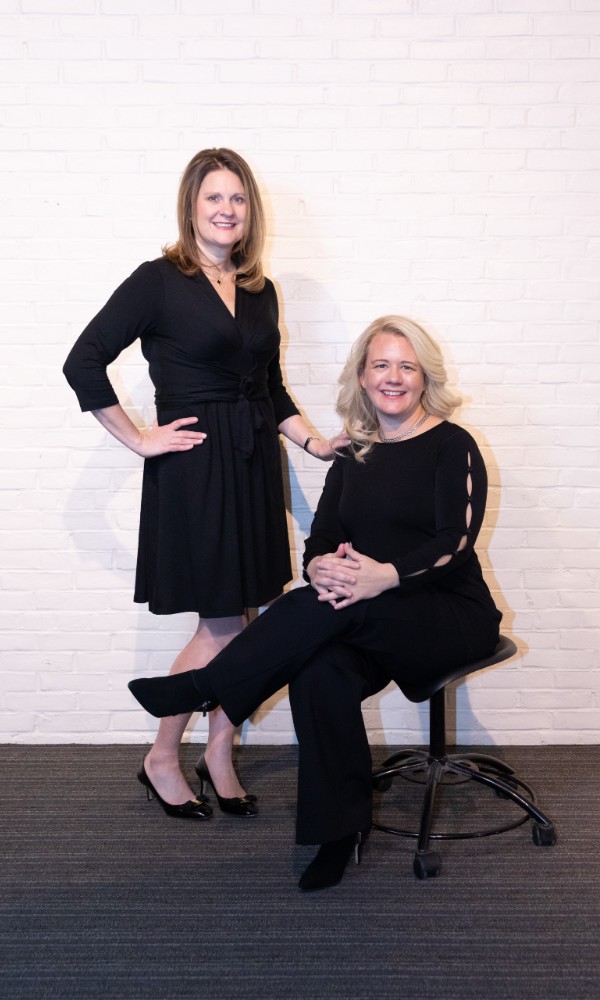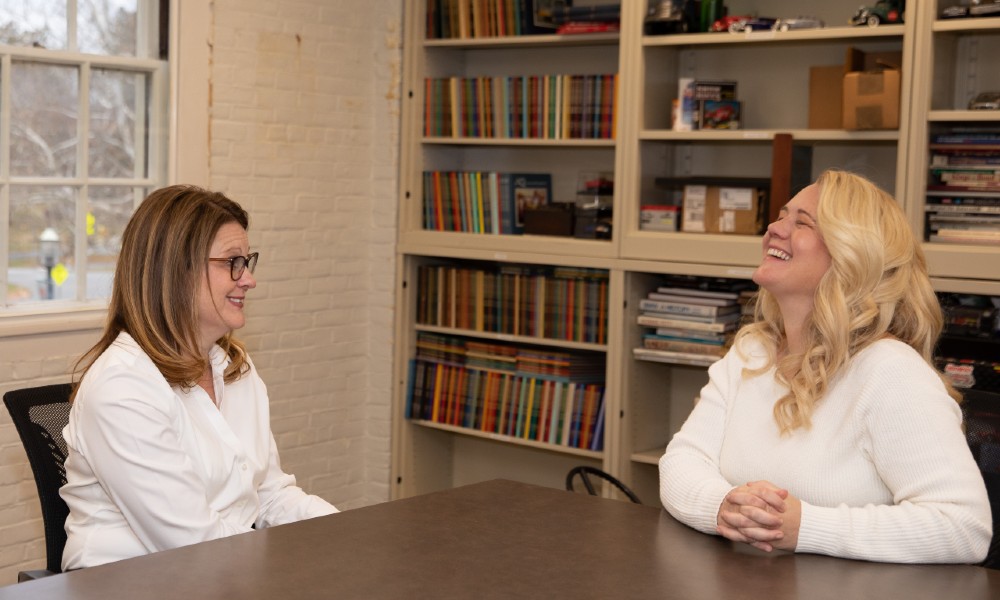Saratoga still has a bit of a reputation for having a certain resistance and reluctance to change, although two years of forced pivots during the pandemic shook that up a great deal. Leading the pack: Carly Connors, executive director of the Saratoga Automobile Museum, and Cate Masterson, director of the National Museum of Racing and Hall of Fame. Both are straight-talking businesswomen breaking new ground to keep museums flourishing in Saratoga for the next generation, while at the same time walking the walk as female leaders in male-dominated worlds. So what does it take to bring new ideas to a historically older Board of Directors with the goal of attracting younger generations into the museum, all while sparking interest in children, who will one day work in horse racing and the auto industry? Their answers during these two toughest months of the year for Saratoga museums are more layered than you might think. —Abby Tegnelia
Let’s start with the elephant in the room. Horse racing and the auto industry are both male-dominated, and you’re both female directors of museums that celebrate those industries. Behind the scenes, how gender-diverse are your worlds?
Carly Connors, executive director of the Saratoga Automobile Museum: I was asked to join the Board six years ago because they wanted to diversify, and I was a younger woman who liked cars. I wasn’t the first, but at the time I was the only woman. Since then, there have been very few women on the Board, the majority of our visitors are men, and the majority of our members are men.
Cate Masterson, director of the National Museum of Racing and Hall of Fame: Women have represented the Board since the beginning. The executive director when the museum opened in 1950 was a woman, Elaine Mann. There has always been a heavy presence of women on our Board. And our staff is 75 percent women.
Connors: That’s impressive.

What’s the difference? Why do so many women run to support the racing museum?
Masterson: It’s a different kind of horsepower. There’s a natural connection with a living animal, an emotional draw, tie and feel that you don’t get with an engine.
Connors: That’s the perfect answer.
Carly, do you think that will ever change in the automotive world?
Connors: I do. You definitely see more women in racing and the hobby of collecting. Danica Patrick was a big one—I thought she would have made a much bigger splash with women. But you’re definitely seeing more women collecting.
What role do you play locally, just by being a woman who loves cars yourself?
Connors: It’s great when we have students come in, and they see there’s a woman executive director. Some are pretty surprised by that—and surprised by my knowledge of cars. We just hired an education director [Rachel Chase] to shore up even more student programs. She’s dynamite.
Masterson: She is awesome. And our educator [Matt Reichel], who’s new too, has already worked with her on three events. They hit it off and are doing all sorts of things.
I love the synergy when it comes to local kids. Worldwide, people are talking about how we can get more young girls and underrepresented groups into STEM [science, technology, engineering and mathematics] classes, and into other fields they might not be exposed to, in order to increase all kinds of diversity. You two are shouldering a lot of that work here, locally.
Connors: Our education director is working on bringing more students in, especially with STEM and showing how it can relate to vehicles, engines and cars. And how it can be fun! You can also look at the design aspect.
Masterson: BOCES has an equine program for 11th- and 12th-graders, and it’s predominantly female. It’s interesting, because I’m guessing the automotive program at BOCES is predominantly male…
Connors: We just had BOCES here last Tuesday, and it was
95 percent male.
Masterson: We’re doing a five-part series with them, which we hope will include an Oklahoma [training track] tour and a hot walking training program. We’re trying to get the youth access to the backstretch. Carly, do we have any mechanical shops that you’re affiliated with?
Connors: We’re hoping to start a restoration program where we’ll have high school kids come in and learn from the older generation. We’re partnering with the local Model A Club, which is similar to the Model Ts. We’re really excited about it. But it’s not seeing interest from females.

Really? I think that sounds fun, like a puzzle to figure out—something that I might have enjoyed when I was younger.
Connors: When they talk about women in STEM, it’s the higher-paying jobs, the doctors and engineers. They never talk to them about mechanics.
Masterson: My boyfriend’s niece just turned 21 and wants to be a welder. I thought it was the coolest thing ever and asked her about it. She said she grew up doing this stuff with her dad.
Connors: That’s where I got my love of cars: My dad was really into cars, so we would talk about cars. That’s how a lot of kids get into it—a dad, an uncle, a grandfather.
That speaks volumes about the generations—the generation before might not have taught their daughters any of that.
Connors: Definitely not.
Do you two ever get sick of being asked about being female? I know that every time I’m referred to as a “female CEO” I’m thinking to myself, “I’m also good at my job.”
[Everyone laughs.]Connors: Yes! Yes! I think, “Aren’t we over that?”
When I first moved here, I didn’t think so. In fact, I felt pushed into what I call a “little lady lane” more than I ever had in California. But maybe during Covid there simply wasn’t time for that, because I have seen vast improvement.
[The group starts to list female leaders in Saratoga, and then shares stories of—in recent memory—being treated differently than male counterparts. Connors and Masterson asked for details to be off the record, but topics the three of us discussed included salary disparity, being talked over by males in group meetings and watching a male be approached for something first at an event. But overall, both women proudly deemed Saratoga gender-neutral.]
What I think I’m hearing is that while gender equality is an important topic right now, the other elephant in the room is getting the next generation in the door.
Masterson: It’s education. It really is. We have a very good relationship with NYRA, where we can have a space at the track that we can promote the museum as an educational program across the street. We just had our first-ever bilingual exhibit. We went from “Women in Racing” to “Betting on America: The Immigrant Experience.” It was amazing and so well received. We’ve done events to get the backstretch workers in, but this really brought them in.
Connors: For us, getting the younger generation meant really looking at our exhibits and thinking outside the box. The RADwood exhibit, about the cars from the ’80s and ’90s, brought in a whole new demographic for us. And then James Bond [Bond in Motion, the current exhibit] did the same. We needed to rethink what we were showing at the museum. And now we’re getting younger volunteers and new, younger members.
Masterson: And you have to change more than before. You used to be able to have an exhibit for two years. Now? No way. Six months. We’re constantly changing because we can’t be a place you visit once every 10 years. We need people to come back every season or at least once a year.
Connors: And you have to keep up with social media to get younger people in the door.
Masterson: Do you Tik Tok?
Connors: We don’t Tik Tok. Do you Tik Tok?
Masterson: We don’t Tik Tok.
Connors: I really want our Board to do a Tik Tok dance. We’re so lucky we have Zach [Skowronek, communications director] to do our social media. He gets it. Well, he
doesn’t get Facebook, but I help with that. He’s like, “It just doesn’t make sense.”
Masterson: Yeah that’s too old for him.
Connors: During a RADwood meeting, no one on staff knew what CliffsNotes were; they were too young. But on the [older] Board, very few knew what [’80s and ’90s lifestyle brand] RADwood was. Some still don’t get it. The Bond exhibit they got. But they embraced all of it.
Masterson: We’re planning Secretariat’s 50th anniversary. That goes back to 1973, so we have to make it relevant to today’s youth. It’s tough.

It’s interesting to hear about the generational layers that exist within your organizations and how serious these discussions are.
Connors: We have to.
Masterson: Otherwise, we’re not going to be here.
What else are you thinking about right now?
Masterson: January and February are tough for places that are open year-round in Saratoga.
Connors: Winter is our most difficult time because numbers are down, and we can’t have our outdoor events like we do in the summer. We go down to five days a week.
Masterson: Same.
What does the immediate future look like?
Masterson: We’re doing a February fundraiser. We’ve never done one before! On February 4, our Countdown to the Triple Crown will be exactly three months to the day before the Derby. It will be low-key to get people excited about the spring.
Connors: We have an auction in Florida that same weekend. This will be our second year down in Naples. We split the proceeds with an amazing organization called St. Matthew’s House.
And long-term?
Masterson: We’re always thinking, “How can we change the mindset that museums are a thing of the past?”
Connors: Yes! A museum doesn’t have to be stuffy.
